INTRODUCTION
In 1898, the United States fought a war with Spain. It was a “splendid little war” as one leader called it. Few Americans died. The army and navy showed that they were good at fighting and America won a lot of new land. In short, it was a big success.
After the war, the people of the Philippines started fighting the United States because they wanted independence. It was a long, terrible war.
While the Spanish-American War was an easy win, the Philippine-American War showed that being an imperial country can be very hard.
Did the United States deserve what it got after fighting Spain? Did we deserve the trouble we had in the Philippines?
In short, did we deserve both the good and the bad that came out of these two wars?
CUBA
America and Cuba are two separate countries, but the connection between them goes back long before the Imperialist Era. Even before the Civil War, southern planters had thought about making Cuba a part of the United States as a way of adding another slave state to the Union. In the end, this didn’t happen, and Cuba stayed a Spanish colony, but because Cuba is so close to Florida, many Americans were still thinking about it.
Cubans were not happy about the idea of being annexed by the United States, but by the late 1800s, they really didn’t want to be a colony of Spain. Most other countries in Central and South America had been independent for a long time.
Revolts against the Spanish were becoming common. When slavery ended in 1886 in Cuba, former slaves joined with farmers and the workers in the cities to fight for change. Many rich Cubans lost their land, and the number of sugar mills went down. Only companies and the richest plantation owners stayed in business. It was during this time that Americans started to buy the sugar plantations in Cuba that were closing down. Although it was still a Spanish colony, the United States was becoming more and more important for Cuba’s economy.
In 1881, the Cuban leader José Martí moved to the United States to get away from the Spanish who wanted to put him in jail. In America, we worked with other Cubans to get the United States to help them win independence from Spain. He also worked to make sure the United States didn’t try to annex Cuba, which some American leaders still wanted.
Americans mostly wanted to help the Cubans in their fight for independence. The United States had gone through a similar fight with Great Britain a century before and felt like it was their chance to help someone else. The Cubans, led by José Martí, had done a good job of telling Americans about their problems. Sometimes the Cubans had even damaged American sugar mills and railroads in Cuba as a way to get Americans to get involved. The Cubans thought that if America got involved in their fight with Spain, it would probably be on the side of the Cubans who wanted independence.
Spain did not have any plans to give Cuba its independence and the Spanish government sent 50,000 soldiers to the island. The Spanish general, Valeriano Weyler, created concentration camps to hold Cubans fighters he caught, and overall made life very hard for the Cubans. Americans called Weyler “Butcher Weyler,” and his decisions made Americans even more eager to help the Cubans.
As more and more Americans, and also American leaders said that they should help the Cubans, President McKinley said he would work with Spain for Cuban independence. Spain told him no but did try to make changes so that the Americans would not be so upset. After all, the Spanish leaders did not want a war with the United States which was a growing world power. 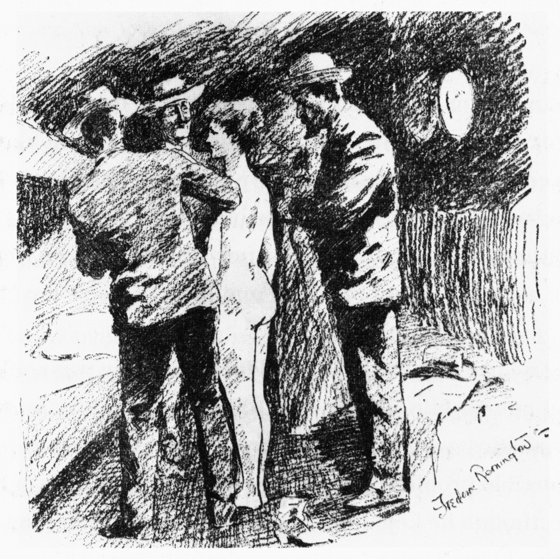 Primary Source: Drawing
Primary Source: Drawing
The provocative, and entirely fictitious, strip searching of American women by Spanish authorities that was reported in William Randolph Hurst’s newspapers. Stories like these inflamed public opinion and pushed President McKinley to ask for a declaration of war.
REMEMBER THE MAINE
Yellow journalism was important during the Cuban conflict. William Randolph Hearst and Joseph Pulitzer were competing for newspaper readers by writing more and more exciting, and sometimes fake stories. Once, Hearst sent a photographer to Cuba to take pictures of the war that he could print in his newspapers, but his photographer sent a telegraph back that there was not any war. Hearst is said to have answered, “You take care of the pictures. I’ll take care of the war!” Hearst printed a sensational drawing on the front page of his Journal of an American woman being searched by Spanish officers. The story was fake, but it sold newspapers. Many historians today think that yellow journalism played a big part in getting Americans angry enough to go to war with Spain.
As people in America were getting angry, President McKinley and General Weyler were both trying to cool things off to avoid a war. Just when it looked like a peaceful deal might be possible, bad luck struck.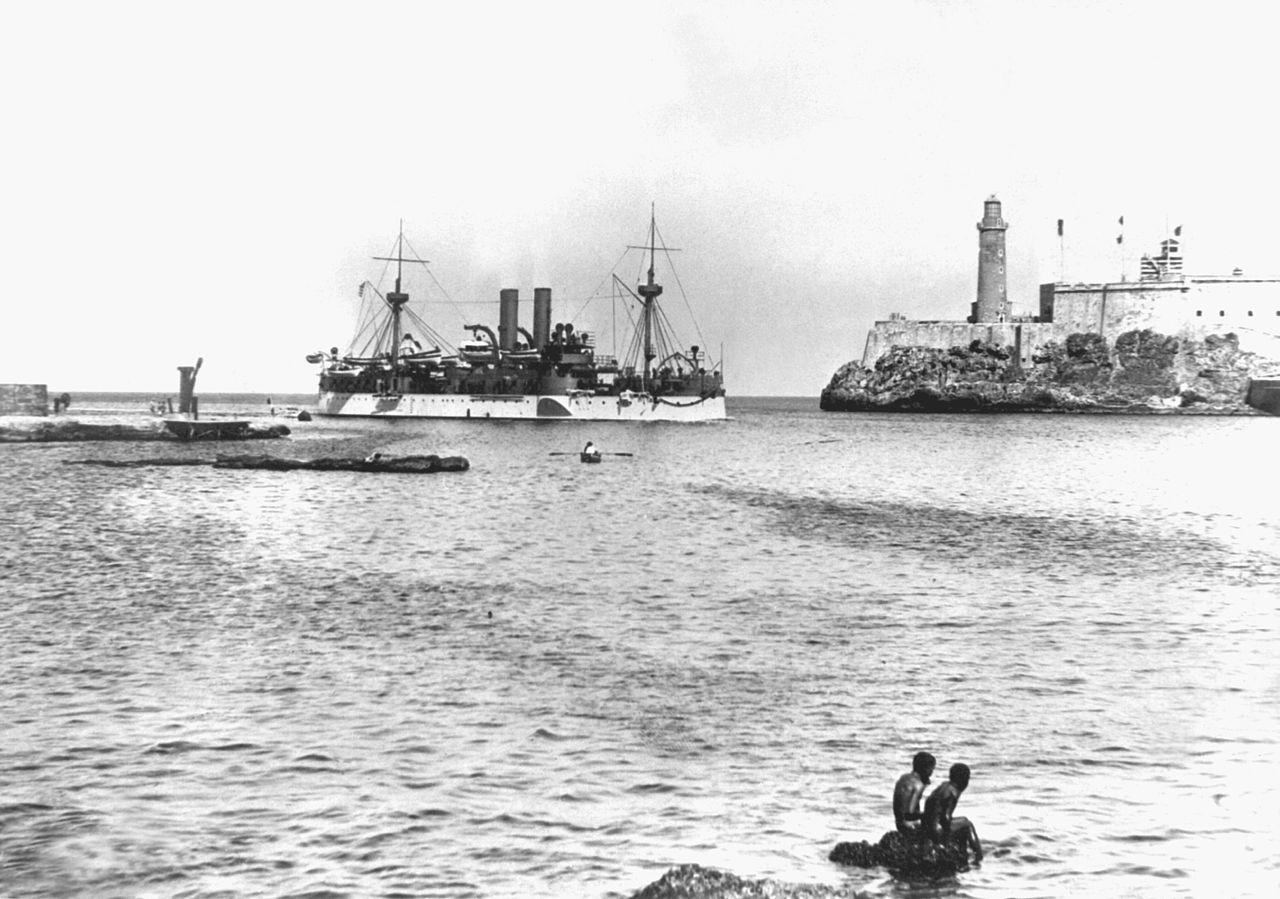 Primary Source: Photograph
Primary Source: Photograph
The USS Maine sailing into Havana Harbor.
Fitzhugh Lee, the American government’s representative in Havana, the Cuban capital city, thought it would be a good idea for the United States to make sure the Spanish knew how powerful the American navy was. He asked the navy to send the USS Maine, a battleship, to visit Havana harbor. It was supposed to be a peaceful visit, but it was definitely America showing off its power.
While the Maine was visiting Havana, a letter written by Spanish ambassador De Lome in the United States was stolen out of the mail by a Cuban revolutionary. He gave it to a reporter of the Hearst newspapers. The letter was full of insults about President McKinley and Hearst printed the letter in the New York Journal. Americans were outraged, and De Lome had to quit and go back to Spain.
One week later the Maine blew up, killing over 200 American sailors. The explosion was probably an accident, but we can never know for sure. Spain did not have any good reason to attack the Maine. After all, they were trying to stay out of a war with the United States, but American blamed them anyway. The yellow press started printing the slogan “Remember the Maine! To hell with Spain!”
But President McKinley still didn’t think war with Spain was such a good idea. Although it is clear that he wanted Spain out of Cuba, even going so far as to offer to buy the island, he was not excited about war. Historians mostly agree, however, that the American people, angered by what they were reading in the yellow press, pushed the president to go to war. In the end, President McKinley, himself a veteran of the Civil War, asked Congress to declare war on Spain and on April 25, 1898, the United States officially went to war with Spain. An amendment, or addition or change to a law, known as the Teller Amendment, was added to Congress’s declaration or war, saying that the United States was not fighting the war to take Cuba and make it an American colony.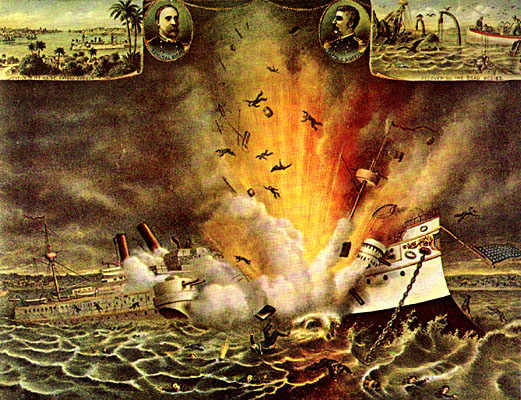 Secondary Source: Painting
Secondary Source: Painting
No photographs of the actual explosion of the Maine exist. This is one artist’s depiction of the event which certainly captures the nation’s horror.
THE SPLENDID LITTLE WAR
The Splendid Little War, as it was later called by Secretary of State John Hay, was easily won by the United States. Americans supported the war happily, and many young men volunteered. However, the regular army, which had done little but fight Native Americans since the Civil War, was not prepared to manage the change from peace to war and mobilization was slow, disorganized and it was months before any American soldiers actually landed in Cuba.
The navy, on the other hand, was ready. Because of Mahan’s book and leaders like Theodore Roosevelt, the government had just spent a lot of money building up the navy. The navy fought well from the beginning. Commodore George Dewey and his American ships beat the Spanish fleet in Manila Bay in the Philippines. The United States navy also beat the Spanish fleet off the coast of Cuba. However, moving ships between the Atlantic to the Pacific Oceans during the war showed Americans just how important it was to dig a canal in Central America.
Although the army was disorganized, many men had signed up, including Theodore Roosevelt who quit his job in government to lead the Rough Riders. American soldiers fought bravely and beat the Spanish army near Santiago. Americans also took over Puerto Rico, another Caribbean island Spanish colony. The fighting lasted less than four months. Less than 400 American soldiers died in the fighting, but more than ten times as many died from sickness.
The most popular picture of the Spanish-American War is of Theodore Roosevelt and his Rough Riders, charging up San Juan Hill. One thing Americans often don’t know is that the Rough Riders would not have done as well if they had not been helped by more than 2,500 Black soldiers, who joined them in battle. These soldiers, who had been fighting the Indian Wars for many years, were key in the victory in Cuba.
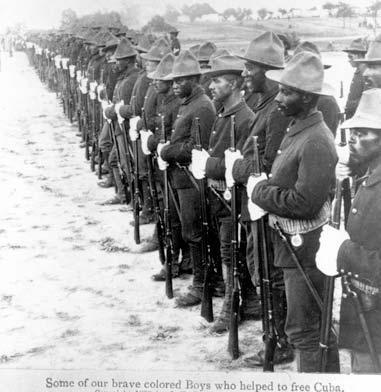 Primary Source: Photograph
Primary Source: Photograph
Some of the African American troops who fought in Cuba. Many of them were veterans of the Indian Wars in the West where they had been called Buffalo Soldiers by the Native Americans. In Cuba, they were given the nickname Smoked Yankees.
The choice to serve in the Spanish-American War was not a simple one. Within the African American community, many spoke out both for and against the war. Some felt that because they were not given equal rights it was not their job to join the war. Others said that joining the army was a way for African Americans to show the rest of the country that they could be equal to White Americans. The army needed experienced soldiers and was happy to have African Americans join, but the Black soldiers still had to deal with racism and were not treated well in the southern states they visited before leaving for Cuba.
Once in Cuba, however, the Smoked Yankees, as the Cubans called the African American soldiers, fought side-by-side with Roosevelt’s Rough Riders. After the Battle of San Juan, five African American soldiers were given the Medal of Honor and 25 others were given awards as well. One reporter wrote that the Rough Riders could not have won without the help of the African Americans. For some of the soldiers, this made joining the army worthwhile. Others, however, felt more of a connection with the Afro-Puerto Ricans and Afro-Cubans than they did to the Whites of their own country.
THE PHILIPPINE-AMERICAN WAR
As the war ended, Spanish and American leaders met for a peace conference in Paris. The Spanish wanted to keep the Philippines. They felt that the war had been about Cuban independence, and it was wrong for the United States to take the Philippines. President McKinley did not want to give up the Philippines. For sure, he did not want to give the islands back to Spain, but he also was afraid that another European country might try to take over the Philippines if the Americans did not. Because of racist feelings about the Filipinos, the Spanish and Americans never even thought about giving the Filipinos independence. William Howard Taft was the first American governor-general to try to lead the new American colony, and his choice of words show the way many Americans felt at the time. He called the Filipinos “our little brown brothers.”
Filipino leader Emilio Aguinaldo did not like the idea of getting rid of the Spanish just to have the Americans take over instead. He and his followers had been fighting the Spanish for years and after the United States took control of the Philippines, they switched to fighting the Americans. The result was the Philippine-American War, or the Filipino Insurrection. It was one of the ugliest wars in American history.
The Filipinos’ war for independence lasted three years, with over 4,000 American and 20,000 Filipino combatant deaths. Probably 250,000 people who were not soldiers also died during the war. Terrible crimes were committed by American soldiers against both Filipino soldiers and civilians. Upset that things weren’t getting better, President McKinley decided that it would be better to have a civilian lead the American government in the Philippines instead of putting the army’s generals in charge. Things got better under Governor William Taft. Americans built new roads, bridges, hospitals, and schools, hoping to show the Filipino people that things would be ok if they stayed a colony of the United States. It started to work. More people accepted the American leadership, and Aguinaldo was captured by American soldiers and had to promise to follow American laws.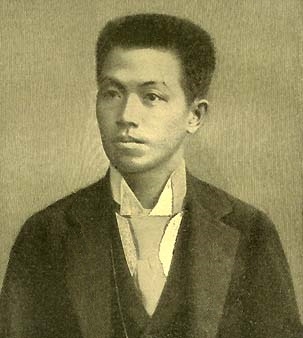 Primary Source: Photograph
Primary Source: Photograph
This photograph of Emilio Aguinaldo was taken in 1898 at the start of the Spanish-American War. As he grew older he continued to play a vital role in the development of his country.
Taft continued making changes that he hoped would make life for regular Filipinos better. He also gave jobs in the government to resistance leaders if they agreed to stop fighting against the Americans.
The war ended on July 2, 1902, with a win for the United States. However, some Filipino groups keep up their fight for independence. Among those leaders was General Macario Sakay who had taken over as leader of the Filipino resistance after the capture of President Emilio Aguinaldo. Other groups, including the Moro people and Pulahanes people, continued to fight against the Americans for ten more years.
Being an American colony changed the Philippines. English became the main language of government, schools, and business. The Catholic Church lost its place as the official religion, although most Filipinos are still Catholic today.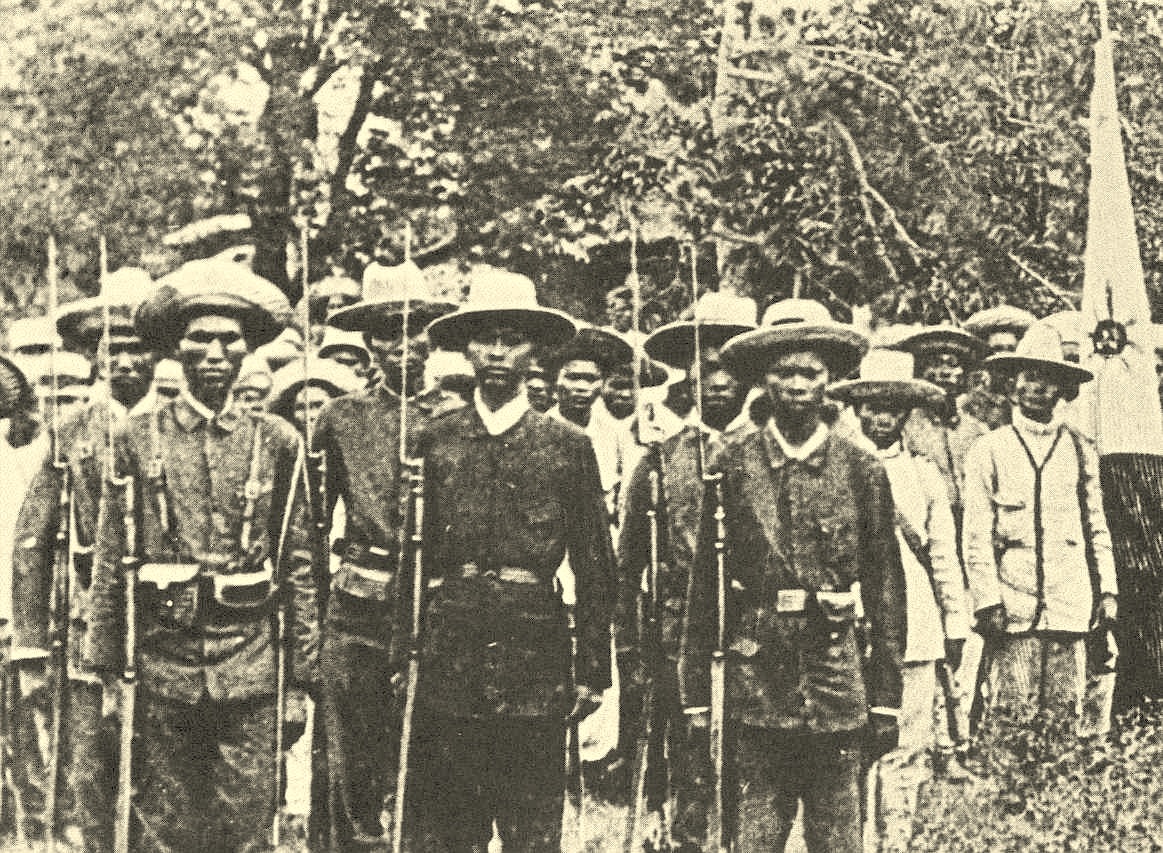 Primary Source: Photograph
Primary Source: Photograph
Katipunenos, Filipinos who continued the fight against the Americans even after Aguinaldo was captured.
In 1916, Congress passed the Jones Act. This law promised that the United States would give the Philippines independence someday, and also gave Filipinos more control until that happened. Finally in 1946, after World War II, the United States gave the Philippines full independence.
OPPOSITION
Some Americans, including William Jennings Bryan, Mark Twain, Andrew Carnegie, and members of the American Anti-Imperialist League, did not like the annexation of the Philippines. Anti-imperialists said that the United States had just taken over from Spain as the colonial ruler of the Philippines and that having colonies was wrong. Other anti-imperialists had racist reasons for not liking annexation. Among these was Senator Benjamin Tillman of South Carolina, who was afraid that annexation of the Philippines would mean more non-White immigrants would start coming the United States. As people read in the newspapers about the terrible things American soldiers were doing in the Philippines, fewer and fewer Americans liked the idea of fighting to keep control. President McKinley and Governor Taft decided to make deals with the Filipinos to end the war partly because they were losing support of their own people.
LEGACY OF THE WARS
The result of the Spanish-American War was the 1898 Treaty of Paris, which was good for the United States. The United States got several island territories. Spain gave the United States control of Puerto Rico, Guam, and the Philippines. Puerto Rico and Guam are still American territories today and the people of those territories are American citizens. Although, since they are not states, they have no representatives in Congress and cannot vote for president.
The wars also are the beginning of the United States being involved in world affairs. Before the Spanish-American War, the United States was mostly isolationist. Isolationism is when a country tries to keep to itself. Although Americans still disagree about how much we should be involved, since the Spanish-American War, the United States has been much more involved in world affairs.
After the Spanish-American War, the United States had many years of business and population growth and technological innovation that lasted through the 1920s. The war changed the way Americans thought about their country. It helped the country come together around a single goal, and also changed the way newspapers reported about big events.
The war put an end to the Spanish Empire. Spain had once been the strongest country in the world but had been losing power all through the 1800s. After the war, Spain lost all of its important colonies. Never again would Spain be among the world’s most powerful countries.
For a few years after the war, the Americans stayed in Cuba. Like Taft in the Philippines, General Leonard Wood led an effort to rebuild the Cuban government, roads, schools, and hospitals. American doctors Walter Reed and William Gorgas exterminated yellow fever in Cuba. As they had promised to do, the Americans left Cuba in 1902.
However, Cuban independence was not total. Congress passed the Platt Amendment of 1903 which limited what the Cubans could do. First, it said that Cuba could not make treaties with other countries unless the United States approved them. The Cuban government could not borrow money if it could not pay it back. And most of all, the United States would be allowed to send the army back to Cuba if American leaders thought things were getting out of hand. And finally, the United States was allowed to build a naval base at Guantanamo Bay. Even though the United States government and Cuban governments don’t get along today, the base at Guantanamo Bay is still under American control.
CONCLUSION
The Spanish-American War gave the United States new colonies, national pride, and showed everyone that America was one of the world’s great countries. While the reasons for going to war might have been questionable, independence for Cuba was a good thing and it happened because of the war. In that way, it seemed like new lands America won were a reasonable reward for helping the Cubans.
In the Philippines, what America got out of the war was not great. People who don’t like the idea of imperialism can look at all the pain and death of the Filipino Insurrection as a reasonable punishment for the United States thinking it knew best how to rule the Philippines.
What do you think? Did we deserve both the good and the bad that came out of these two wars?
CONTINUE READING
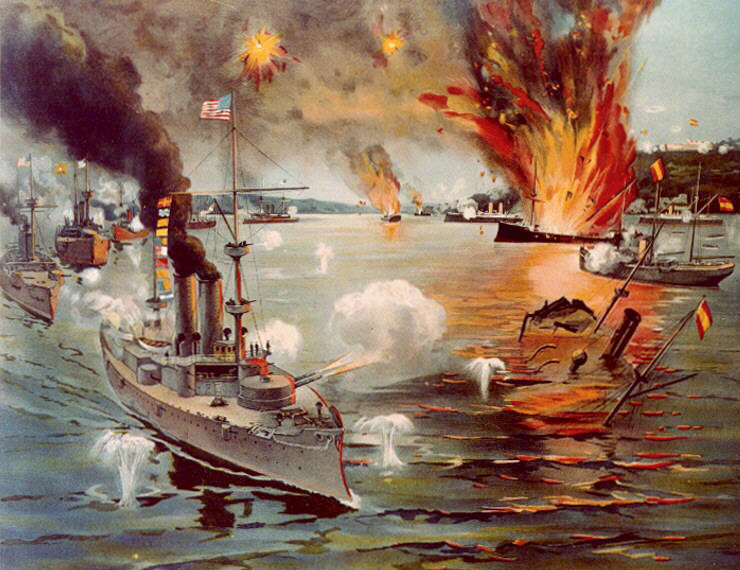
SUMMARY
BIG IDEA: The United States fought a war with Spain that was about Cuban independence, but led to the acquisition of former Spanish territories such as Puerto Rico and the Philippines.
The United States went to war with Spain in 1898 because of Cuba. Cuba was one of the last Spanish colonies in the Americas. Cubans wanted independence, and some people in the United States were sympathetic to the Cuban cause.
At the time, newspapers were competing with each other to sell more copies. Writers and publishers exaggerated stories and used bold, sensational headlines. A popular topic was Spanish cruelty toward Cubans. After reading such stories, many Americans wanted the United States to intervene in Cuba.
The USS Maine, an American battleship, exploded while visiting Havana, Cuba. It is still unclear why the explosion happened, but Americans blamed the Spanish and demanded war.
As part of the declaration of war, Congress passed a law stating that it would not make Cuba an American colony.
The Spanish-American War was a lopsided victory for the United States. American ships destroyed the Spanish fleet in the Philippines and American troops overran the Spanish troops in Cuba. Theodore Roosevelt became a national hero while leading his men in battle in Cuba.
True to their promise, the United States allowed Cuba to become independent, but passed a law saying that they would intervene if there were problems in Cuba. In this way, Cuba was always mostly, but not entirely independent.
As a result of the war, the United States took control of the Spanish territories of Puerto Rico, Guam and the Philippines.
The Filipinos had also been fighting for independence when the war broke out. Filipino leaders thought that the war would lead to independence the same that it had for Cuba. However, after defeating the Spanish, the Americans stayed. The Filipino freedom fighters began a rebellion against American rule. A bloody conflict resulted.
In the end, Americans captured Emilio Aguinaldo, the leader of the Filipino resistance and the rebellion ended. The Filipinos agreed to a deal in which the Americans maintained control of the country but allowed the Filipinos to make many of their own decisions. The United States kept the Philippines as a colony for about 50 years.

VOCABULARY
![]()
PEOPLE AND GROUPS
José Martí: Cuban poet and leader of the Cuban independence movement.
George Dewey: American naval commander at the Battle of Manila Bay during the Spanish-American War.
Rough Riders: Nickname for Theodore Roosevelt’s cavalry regiment in Cuba during the Spanish-American War.
Smoked Yankees: Nickname for African-American troops during the Spanish-American War.
William Howard Taft: American governor of the Philippines after the Spanish-American War and later president of the United States.
Emilio Aguinaldo: Leader of the Philippine independence movement who fought both the Spanish and the United States.
Mark Twain: American author of such books as Tom Sawyer and Huckleberry Finn and famous anti-imperialist.
![]()
KEY IDEAS
Remember the Maine: Rallying cry during the Spanish-American War.
Splendid Little War: Nickname for the Spanish-American War.
![]()
SHIPS
USS Maine: American battleship that exploded mysteriously in Havana Harbor. The explosion was the catalyst for the Spanish-American War.
![]()
LOCATIONS
Cuba: Island nation just south of Florida that was a Spanish colony until the United States secured its independence in the Spanish-American War.
Havana: Capital city of Cuba.
Puerto Rico: Island in the Caribbean won by the United States from Spain in the Spanish-American War. It remains an American territory.
Guam: Island in Micronesia won by the United States from Spain in the Spanish-American War. It remains an American territory.
Philippines: Island nation in Asia won by the United States from Spain in the Spanish-American War. It was granted independence in 1946.
![]()
EVENTS
Explosion of the USS Maine: Event that cause the United States to declare war on Spain in 1898.
Spanish-American War: 1898 conflict with Spain in which the United States won control of Puerto Rico, Guam, the Philippines, and also won independence for Cuba.
Battle of Manila Bay: Naval encounter between American and Spanish ships in the Philippines during the Spanish-American War. It was a total victory for the United States.
Philippine-American War: Conflict between the American army and Philippine independence fighters after the Spanish-American War.
![]()
TREATIES & LAWS
Teller Amendment: Amendment to the declaration of war against Spain in 1898 that state that the United States would not annex Cuba.
Jones Act: 1916 law that promised independence for the Philippines
Treaty of Manila: Treaty that officially granted the Philippines independence in 1946.
Treaty of Paris of 1898: Treaty that ended the Spanish-American War and granted the United States control of Puerto Rico, Guam and the Philippines.
Platt Amendment: Law passed in 1903 in which the United States claimed the right to intervene in Cuban affairs, to maintain a naval base at Guantanamo, and limited the freedom of Cuba to make treaties without American consent.
